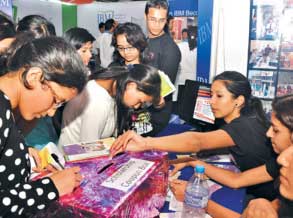A giant leap for education

As the Rana autocracy, which ruled the country for over a century till 1950, was totally against educating the general public, formal education has a short history in Nepal when compared to many other countries in the world.
By 1951, there were only 310 primary and middle schools and 11 high schools and two colleges in the country. It however, still did not have a university then and the students numbered around 10,000. After the Rana regime was thrown out, efforts were made to make education accessible to the general public and in the next three decades the country had three universities, 65 colleges, around 15,000 schools and over 2.5 million students.
The academic sector saw a significant rise after the Panchayat government—which had earlier decided to nationalise all private institutions—realised that only private sector involvement could boost the quality of education and opened the door for everyone in 1980.With the entry of the private sector in the academic field, the country has made overwhelming progress, both in quantity and quality. After the democratic revolution of 1990, new higher education institutions were established according to the ‘multi-university’ concept adopted by the state.
Records for the year 2012 at the Ministry of Education show that there are nine universities, 1,027 colleges and around half a million students in the university level, while over seven million students are studying in around 40,000 schools, including 8,000 operated by the private sector.
Similarly, more than 3,750 higher secondary schools—around 1,250 run by the private sector—are in operation with an annual increment of over five percent. Around a million students are studying in the plus-two level and around 250,000 graduate to university education annually.
“The rise in the numbers has led to competition, which has promoted quality,” said Baburam Pokhrel, coordinator of the Association of Private Educational Institutions, Nepal (APEIN), an umbrella organisation of all private educational institutions across the country.
Records show that there are 832 affiliated and 60 constituent institutions of the Tribhuvan University alone, with around half-a-million students. Similarly, over 200 affiliated and 50 constituent colleges are operating under the Kathmandu, Pokhara, Purbanchal, Lumbini Buddha and Sanskrit universities. Though, a majority of the colleges are providing non-technical education, the share of technical and vocational education, too, is significant. According to data at the Council for Technical Education and Vocational Training, over 420 affiliated, 21 constituent and eight annex schools have been producing over 20,000 technical persons annually at the school and diploma levels. Similarly, around 1,860 seats are available in the MBBS, 775 each in Bachelor in nursing and BSc nursing, around 1,000 in Bachelor in Pharmacy, 600 in Bachelor in Pharmacy, 500 in BDS and around 100 in Bsc MLT.
Over 2,000 engineers are produced annually by around 40 engineering colleges across the country. “Students don’t need to go abroad as every kind of education is available in the country,” said Umesh Shrestha, Chairperson of the Higher Secondary Schools Association Nepal, adding that some of them are of international standards.
With the entry of the World Trade Organisation (WTO) in education services in 2010, dozens of foreign universities and education boards have already been established and they have been providing international degree with affiliation from renowned universities across the globe.
With more institutions mushrooming every year to meet the rising demands of the country, education no longer means a mere acquisition of knowledge, but of life skills values and perspectives that will shape the future of each individual and the larger future of the nation.
Recent trend shows that educational institutions are also vying for excellence, not just for commercial gains, and this has led them to reevaluate their methods of pedagogy.Academic institutions are turning to more creative and open environments where learning comes easy to students rather that being forced upon them. These creative methods have brought the larger world into the classroom in a more child-friendly way and have kept tune with changing trends as well as innovations in technology.
source: Ghimire, Binod (2013),"A giant leap for education", The Kathmandu Post,16 May 2013
Posted on: 2013-05-16





























